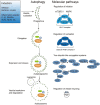Autophagy-Inflammation Interplay During Infection: Balancing Pathogen Clearance and Host Inflammation
- PMID: 35273506
- PMCID: PMC8902503
- DOI: 10.3389/fphar.2022.832750
Autophagy-Inflammation Interplay During Infection: Balancing Pathogen Clearance and Host Inflammation
Abstract
Inflammation is an essential immune response of the host against infections but is often over-activated, leading to a variety of disorders. Autophagy, a conserved degradation pathway, also protects cells by capturing intracellular pathogens that enter the cell and transporting them to the lysosome for clearance. Dysfunctional autophagy is often associated with uncontrolled inflammatory responses during infection. In recent years, more and more research has focused on the crosstalk between autophagy and inflammation. In this paper, we review the latest research advances in this field, hoping to gain insight into the mechanisms by which the body balances autophagy and inflammation in infections and how this mechanism can be used to fight infections better.
Keywords: autophagy; bacteria; infection; inflammasome; inflammation; microbial; virus.
Copyright © 2022 Pang, Wu, Tang, Wang and Wei.
Conflict of interest statement
The authors declare that the research was conducted in the absence of any commercial or financial relationships that could be construed as a potential conflict of interest.
Figures


Similar articles
-
Inflammasomes, Autophagy, and Cell Death: The Trinity of Innate Host Defense against Intracellular Bacteria.Mediators Inflamm. 2019 Jan 8;2019:2471215. doi: 10.1155/2019/2471215. eCollection 2019. Mediators Inflamm. 2019. PMID: 30728749 Free PMC article. Review.
-
Interplay Between NLRP3 Inflammasome and Autophagy.Front Immunol. 2020 Oct 9;11:591803. doi: 10.3389/fimmu.2020.591803. eCollection 2020. Front Immunol. 2020. PMID: 33163006 Free PMC article. Review.
-
Inflammasome, mTORC1 activation, and metabolic derangement contribute to the susceptibility of diabetics to infections.Med Hypotheses. 2015 Dec;85(6):997-1001. doi: 10.1016/j.mehy.2015.08.019. Epub 2015 Sep 6. Med Hypotheses. 2015. PMID: 26384528
-
Autophagy and Ubiquitination in Salmonella Infection and the Related Inflammatory Responses.Front Cell Infect Microbiol. 2018 Mar 14;8:78. doi: 10.3389/fcimb.2018.00078. eCollection 2018. Front Cell Infect Microbiol. 2018. PMID: 29594070 Free PMC article. Review.
-
Dining in: intracellular bacterial pathogen interplay with autophagy.Curr Opin Microbiol. 2016 Feb;29:9-14. doi: 10.1016/j.mib.2015.09.004. Epub 2015 Oct 21. Curr Opin Microbiol. 2016. PMID: 26462048 Free PMC article. Review.
Cited by
-
Regulation of autophagy gene expression and its implications in cancer.J Cell Sci. 2023 May 15;136(10):jcs260631. doi: 10.1242/jcs.260631. Epub 2023 May 18. J Cell Sci. 2023. PMID: 37199330 Free PMC article. Review.
-
Repressive Control of Keratinocyte Cytoplasmic Inflammatory Signaling.Int J Mol Sci. 2023 Jul 26;24(15):11943. doi: 10.3390/ijms241511943. Int J Mol Sci. 2023. PMID: 37569318 Free PMC article. Review.
-
Functional interplay between non-canonical inflammasomes and autophagy in inflammatory responses and diseases.Korean J Physiol Pharmacol. 2025 Mar 1;29(2):129-138. doi: 10.4196/kjpp.24.240. Epub 2024 Nov 14. Korean J Physiol Pharmacol. 2025. PMID: 39539180 Free PMC article. Review.
-
The impact of nanomaterials on autophagy across health and disease conditions.Cell Mol Life Sci. 2024 Apr 17;81(1):184. doi: 10.1007/s00018-024-05199-y. Cell Mol Life Sci. 2024. PMID: 38630152 Free PMC article. Review.
-
Resolvin D1 attenuates depressive-like behavior in LPS-challenged mice by promoting microglial autophagy.Inflammopharmacology. 2023 Aug;31(4):2061-2075. doi: 10.1007/s10787-023-01234-9. Epub 2023 Apr 27. Inflammopharmacology. 2023. PMID: 37103692
References
-
- Abdulrahman B. A., Khweek A. A., Akhter A., Caution K., Tazi M., Hassan H., et al. (2013). Depletion of the Ubiquitin-Binding Adaptor Molecule SQSTM1/P62 from Macrophages Harboring Cftr △f508 Mutation Improves the Delivery of Burkholderia Cenocepacia to the Autophagic Machinery. J. Biol. Chem. 288, 2049–2058. 10.1074/jbc.M112.411728 - DOI - PMC - PubMed
Publication types
LinkOut - more resources
Full Text Sources

